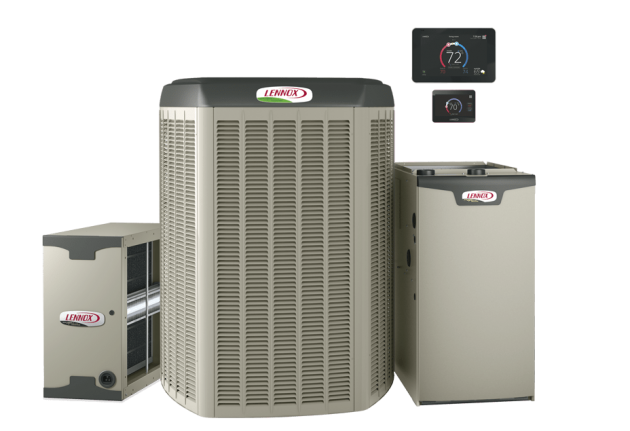In order to achieve all year round comfort, it’s vital to have an efficient heating and air conditioning system that you can rely on. This will allow you to cool your home in summer and heat it during late fall and into the depths of winter without breaking the bank in the process. So, when one of these systems starts to show their age, it’s natural to want to replace it quickly and “save money” by keeping the other system working. But, although this may seem like a sound strategy, it’s actually a smarter move to replace both systems at the same time. In fact, replacing the air conditioning system and furnace together may save you money in the medium to long term and significantly reduce your overall energy bills.
3 Advantages to a Joint Replacement Strategy
Generally speaking, there are three main advantages to replacing both your air conditioning and your furnace at the same time. They are technological advances, avoiding mismatching problems, and improving energy efficiency. We will break all three down in more detail below, but it’s worth mentioning here that we believe that a joint replacement strategy in the vast majority of cases is the best option to improve your indoor comfort and save money at the same time. Let’s get started.
- Technological Advances
Like any modern industry, the HVAC sector is undergoing constant evolution in terms of performance, usability, and energy efficiency. An air conditioning system or furnace installed only a couple of years ago will not be as efficient as a system installed today. The situation is exacerbated if you try to match together an older and a newer system to create an overall heating system.
As an example: Let’s say your furnace is breaking down frequently. Its energy efficiency is compromised, so you want to install a new furnace for the winter. If your air conditioning system is a little younger, you may be tempted to keep it and integrate a new furnace into your HVAC system. But, the introduction of a new modern furnace will not improve the performance or energy efficiency of your air conditioner. In fact, if anything the overall performance and efficiency will be compromised, and you will not get that boost in performance and efficiency that you paid for when you purchased and installed the new furnace.
When you purchase an air conditioner and furnace that are designed to work together, there are considerable advantages. The new technology can be used to its full potential because the technology in each system will complement each other. This is particularly important when you think about the air handler and how it works with both the cooling and heating system to distribute the treated air effectively.
A combined central air conditioning system and furnace is composed of six vital components; they are the compressor, the outdoor condenser, the indoor evaporator coil, the air handler, the copper tubing and the thermostat which acts as the brain for the entire system. If you purchase a matched system, these six components have been designed to work witch each other to achieve the maximum possible efficiency. When you install an HVAC system like this, you can save money on installation, servicing, and maintenance costs. The process of working on your system is easier than mismatched equipment, and you won’t need to pay for a second installation later. A matched HVAC system is covered by a single warranty which can simplify any claim that you may need to make in the future.
- Avoiding Mismatching Problems
If the homeowner or property manager decides to replace either of their HVAC systems separately, this can lead to mismatching problems. Attempting to combine older and newer equipment can lead to a great deal of frustration, a reduction in home comfort and costs that would not be incurred with a matched system. The useful lifespan of the heating or cooling equipment can be significantly reduced, and if the new system breaks down during the warranty period, the manufacturer may not be obliged to honor the warranty at all. After all, if the new system is being forced into service alongside aging equipment, it will affect the performance and energy efficiency considerably. It may seem cheaper to replace the air conditioning and furnace separately, but spending more will pay off in the medium to long term.
- Improving Energy Efficiency
The demand for higher energy efficiency has been driven by the environmental movement and the increasing costs of energy. We’ve all seen the price hikes in a wide variety of fuel sources, and this has forced manufacturers to invest heavily in researching more efficient technologies. The air conditioning and heating systems manufactured now and far more energy efficient than those built only a decade ago.
There is a great deal of choice available when you start to research AC systems. The best way to compare how efficient air conditioning systems are with each other is to look at the SEER rating for each piece of equipment. The Seasonal Energy Efficiency Ratio or SEER rating ranges from 1-10 and the higher the number, the more efficient that piece of equipment will be in your home. For a modern home AC system, a minimum SEER rating of 13 should be your starting point. Obviously, the higher the SEER rating, the more the equipment will cost, but the energy saving will be significant.
A new furnace will be rated with the Annual Fuel Utilization Efficiency or AFUE rating. This is a measure of how the furnace performs during a heating season. As a rule of thumb, it’s advisable to go for a furnace with an AFUE rating of 90% or higher. This type of furnace will be energy efficient and work well with a matched air conditioner system.
If you want to know more about replacing your aging, inefficient air conditioning and furnace with a new matched system, get in touch with your local HVAC specialist for expert help and advice.

